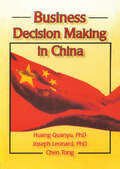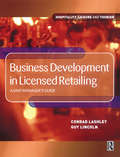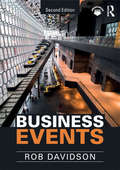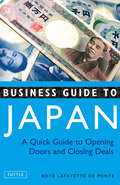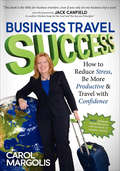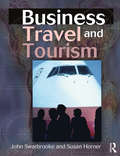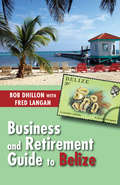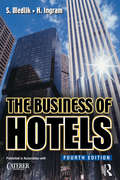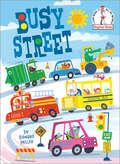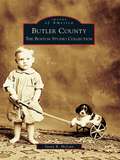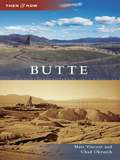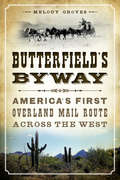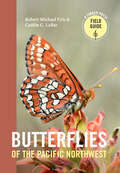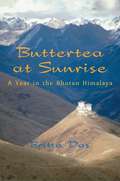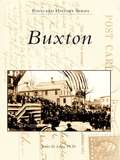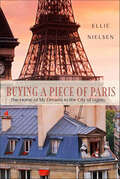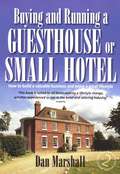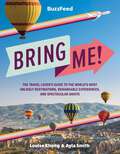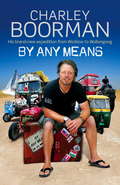- Table View
- List View
Bush Pilot's Wives: Dedicated to the bush pilot's wives
by Lenora ConkleThis book is dedicated to the bush pilot's wives. Women were part of the exciting bush flying. Women worked alongside their men and endured the same hardships. They laughed, loved, and gave birth to new generations. Some were of an era in Alaska when those early bush pilots were making legends. Some were pilots and big game guides themselves and made legends of there own. Bush Pilots' Wives is about real Alaskans and the qualities of those sturdy women, as well as the men, who have made Alaska what it is today. Just as it has been down through the ages, women wait at home doing what has to be done when their men are gone to war or to other places men go to protect and provide for their family. Sometimes that home is a remote village, Nome, Bettles, or some such place. Wherever it is, the bush pilot's wife copes with all types of inconveniences, raising the kids without indoor plumbing and modern conveniences, and overcoming the additional emergencies that always happen. Bush Pilots' Wives is for and about these special Alaskans.
Business Decision Making in China
by Huang Quanyu Chen Tong Joseph W LeonardKnowledgeable decision making not only saves you time, money, and effort, but also leads you to extra opportunities. Business Decision Making in China improves your business acumen by showing you who (in itals) is involved in business decision making, how (in itals) decisions have been made, what (in itals) the characteristics and strategies of Chinese decision making are, and why (in itals) decision making has followed certain patterns in China. Practitioners, consultants, and government officials who are involved in business with China as well as academicians researching or teaching about business in East Asia will find this book to be an invaluable resource. Business Decision Making in China introduces you to such subjects as Chinese organizational structures and relationships, tactics of decision making, and traditional Chinese culture. Other vital topics you learn about include: the pros and cons of joint venture enterprises in China the climate for foreign banks operating in China the importance of saving face the concept of “the golden mean” the unity of opposites (Yin-Yang) the 4 realms of Chinese managers’daily affairs modes of thinking (universality versus individuality, thinking in images, understanding abstract thoughts) the parallels between the 5 elements (metal, wood, water, fire, earth) and the 4 P’s (product, price, promotion, place)As a guidebook for Chinese business, Business Decision Making in China addresses the broad and integrative discipline of decision making and helps Western business people (who have an entirely different set of patterns, styles, processes, philosophical thoughts, and tactics of decision making) to adapt to their Chinese business partners’or opponents’decision making. Since this book explains the profound process of Chinese decision making in uncomplicated terms and practical business experiences, readers will be able to apply their new knowledge to their long-range strategic planning, to skillfully solving their daily problems or questions, and to wisely avoiding losses from a multitude of potential pitfalls.
Business Development in Licensed Retailing
by Conrad Lashley Guy Lincoln'Business Development in Licensed Retailing: a unit manager's guide' details the indispensable skills and techniques needed to manage units within licensed retail organisations in a flexible and entrepreneurial manner. This book: · Forms the basis of a complete course for a unit manager's development.· Provides an overview of the range of skills needed for effective unit management. · Supports the development of techniques with examples from existing best practice and case examples from companies such as JD Wetherspoon's, TGI Fridays and McDonald's amongst others.Business Development in Licensed Retailing considers the functional management techniques required at unit management level, covering recruitment, human resource management, operations, service quality and customer relations, financial measurement and analysis, promotions and strategic planning. The analysis systematically provides all the practical know-how you need to produce of a comprehensive business plan for your unit. Ending with a comprehensive case study that demonstrates all the aspects of business development working in a real-life scenario, the text is ideally suited for lecturers and management development personnel to use as a learning resource through which readers can apply the principles and techniques outlined.
Business Events (Events Management Ser.)
by Rob DavidsonThe dynamic and fast-expanding business events sector plays a vital role in the professional lives of hundreds of millions of people worldwide by providing settings in which they can meet for the purposes of negotiation, deliberation, motivation, the dissemination of knowledge, and the celebration of their greatest career-related achievements. This book provides a sound practical and theoretical context for the study of this subject by covering, in depth, all categories of business-related events including corporate meetings, association conferences, political events, incentive travel, exhibitions, corporate hospitality, awards ceremonies and SMERF (social, military, educational, religious and fraternal) gatherings. This new edition has been extensively revised and updated to reflect recent developments in business events, including: Five new chapters on business events destination marketing, knowledge, sustainability, ethics and technology New ‘It’s my job’ voice boxes offering practical insights from people employed in the business events industry A wide range of new case studies illustrating business events throughout the world, including emerging business events destinations such as Russia and the Middle East Written in an accessible yet analytical manner, Business Events is essential reading for all students of events, tourism and hospitality management.
Business Guide to Japan
by Boye Lafayette De MenteConducting business in Japan: a delicate and valuable skill is explained by a true master of Japanese culture.Not only is Japan the world's third largest economy, it is a global center for design for non-Japanese businesses looking to expand into international markets.But business people from outside Japan quickly discover that doing business in Japan is unlike anything they've experienced before. They find Japanese business culture both highly regimented and maddeningly impenetrable-making it difficult to identify, much less approach, key decision-makers, or to bring negotiations to a successful close.Japanologist Boye Lafayette De Mente explains the key aspects of Japanese business practices and protocols with specific advice for approaching and engaging with Japanese executives, their staffs, and their organizations.Business Guide to Japan offers you invaluable insights into how to unravel the complicated maze of business bureaucracy, interpret verbal and written messages from your contacts, and create the critical social "comfort zone" necessary for working with Japanese companies. Doing business with the Japanese can be both challenging and rewarding, and the Business Guide to Japan offers you precise guidelines for success.
Business Passport to Japan
by Sue Shinomiya Brian SzepkouskiThis updated guide offers a fresh, interactive approach to doing business in Japan by presenting practical tips in an easy-to-read format. It goes beyond the logistical details of meetings, courtesy, and protocol to uncover the thought processes and cultural values behind the behaviors and situations readers may encounter--especially those that are changing as Japan's "blue suit" corporate culture gives way to a younger, laid-back, and more Internet-savvy workforce. Throughout the guide, readers are encouraged to take the long view to develop lasting successes. Indispensable for newcomers and veterans alike. Sue Shinomiya (Portland, OR) and Brian Szepkouski (New York City area) are consultants with extensive experience working in Japan.
Business Travel Success: How to Reduce Stress, Be More Productive & Travel with Confidence
by Carol MargolisDo you find yourself dreading an upcoming business trip? Do you fear gaining weight while away? Are you feeling guilty about not being home with your family? Do you find it difficult to manage your time when you are away? Do you worry about safety when traveling? Do you know how to get through airport security with ease and not let jet lag get you down? Now, in this comprehensive business travel/life management book, get answers to these questions and hundreds more. Business Travel Success was written for all business travelers, whether traveling once a year or every week. It is packed with tips and strategies to make your travel safer, less worrisome, more efficient, and in better harmony with your life. You will find unique tips on how to take care of your home while away, enjoy solo travel, find new relationships, take advantage of social media, and eat healthy on the road. There is advice on packing, driving, flying, renting a car, getting the most from a hotel room, international travel, and much more. On a tight travel budget? Even if you attend only one conference, seminar, or workshop a year, you will discover the answers to make your travel more enjoyable. If you are looking for ways to reduce travel stress, be healthier, have a harmonious work/family travel life, be more productive, and travel with more confidence, then look no further! Business Travel Success is for you!
Business Travel and Tourism
by John Swarbrooke Susan Horner'Business Travel and Tourism' provides a comprehensive, international overview of business tourism from both a theoretical and practical perspective. With the use of case studies from around the world, 'Business Travel and Tourism' explores a broad range of issues, including:* The global business tourism market* The design of business tourism facilities* The role of the destination in business travel and tourism* The social, economic, and environmental impacts of business tourism* The ethical dimension of business tourism* The marketing of business tourism products* The impact of new technologies on the business tourism market* How to organise successful conferences, exhibitions, and incentive travel packagesCase studies include Disneyland Paris, Hong Kong, Amsterdam RAI International Exhibition and Congress Centre, Hilton, Page and Moy Marketing, Lufthansa, Air France, and Legoland UK.'Business Travel and Tourism' is the first text to offer a comprehensive overview of the growing but neglected area of business tourism. With the use of a wide range of up-to-date case studies and major practical exercises to help students to broaden and deepen their understanding of this area of tourism, it is an invaluable text for all students on travel and tourism courses at degree and BTEC/HND level, or those taking tourism options in leisure, business studies, hospitality management or geography.
Business and Retirement Guide to Belize: The Last Virgin Paradise
by Bob Dhillon Fred LanganBelize is an English-speaking tropical paradise, with an azure Caribbean coast, accessible rainforest, lost jungle cities, and a cost-of-living that makes it affordable for Canadians, Americans, Europeans, as well as the emerging middle class of Mexico and Central America. It is one of the worlds most undiscovered secrets, a retirement haven and a safe place to park your money. Business and Retirement Guide to Belize is an introduction to living, working, and retiring in Belize, as well as owning property there. Bob Dhillon introduces the reader to the country, its beauty and friendly people, as well as to its economic attractions. Belize is a moveable feast and the better you get to know it, the more you will enjoy it.
Business of Hotels
by Hadyn IngramThe fully revised edition of this well-known text by an experienced author, consultant and educator follows the structure and approach which has proved so successful since its first publication in 1980. The book examines the hotel as a businessproviding commercial hospitality. It focuses on markets, money and people, and uses examples from hotel operations throughout the world. This new edition is the outcome of a thorough revision of an established text. The new material includes a comprehensive profile of the hotel business in the 1990's and includes data, quotes and extracts from a wide range of authoritative industry sources.
Busy Street (Beginner Books(R))
by Edward MillerA new Beginner Book all about vehicles, featuring favorite things that go!On a busy street in a busy town, cars and trucks go zipping 'round. Buses, trains—watch them go! How many vehicles do YOU know?Buckle up and join Mommy and Bonnie on their drive as they encounter more than 20 types of vehicles! From garbage trucks and school buses to fire engines and police cars, working vehicles can be spotted all over town—and each plays an important role. Beginner Books were created by Dr. Seuss to encourage children to read all on their own. Vehicle enthusiasts will take pride in cruising through Busy Street's simple rhyming text, perfect for beginning readers ages 3 to 7. And with Edward Miller's fun, colorful illustrations, little ones will want to take this book for a spin time and time again.
But Mama Always Put Vodka in Her Sangria!: Adventures in Eating, Drinking, and Making Merry
by Julia Reed“[Reed] has compiled here food-focused curiosities sprinkled with a dash of travel, a pinch of sass, and a whole load of recipes.” —Publishers WeeklyJulia Reed, a master of the art of eating, drinking, and making merry, takes the reader on culinary adventures in places as far flung as Kabul, Afghanistan and as close to home as her native Mississippi Delta and Florida’s Gulf Coast. Along the way, Reed discovers the perfect Pimm’s Royale at the Paris Ritz, devours delicious chuletons in Madrid, and picks up tips from accomplished hostesses ranging from Pat Buckley to Pearl Bailey and, of course, her own mother.Reed writes about the bounty—and the burden—of a Southern garden in high summer, tosses salads in the English countryside, and shares C.Z. Guest’s recipe for an especially zingy bullshot. She understands the necessity of a potent holiday punch and serves it up by the silver bowl full, but she is not immune to the slightly less refined charms of a blender full of frozen peach daiquiris. And then there are the parties: shindigs ranging from sultry summer suppers and raucous dinners at home to a Plymouth-like Thanksgiving feast and an upscale St. Patrick’s Day celebration.This delightful collection of essays will show you how to entertain guests with style, have a good time yourself and always have that perfect pitcher of sangria ready at a moment’s notice.“If this doesn’t make you hungry, and thirsty, call the doctor, you are sick.” —Roy Blount Jr.“A voice that never loses its originality, freshness, and supreme wit.” —James Villas, author of Pig: King of the Southern Table and Crazy for Casseroles
Butler County (Postcard History)
by Randy Mcnutt Cheryl BauerSettlement in Butler County began when Fort Hamilton was built on the Great Miami River in 1791. For the next century, water shaped the county's fortunes. Settlers built towns, commerce moved on the river, and mills and factories grew up along the Miami and Erie Canal and its hydraulic canals in Hamilton and Middletown. The devastating 1913 flood tested residents' resolve and reshaped parts of the landscape. Despite losses caused by the flood, the county's important landmarks remained. The vintage postcards presented here illustrate Butler County life from the days of the fort through the 1950s. A special chapter honors Miami University, which was chartered in 1809. Miami has become a beacon of learning set among the fields and the alma mater of thousands.
Butler County: The Boston Studio Collection (Images of America)
by Susan R. MclainHarvey L. Boston opened the Boston Studio in downtown David City in 1893. For about the next 35 years, Boston personally recorded the people and places of Butler County using photography. Boston had an eye for detail, and through his photographs, one is able to inspect and appreciate the clothing of the early years of the 20th century: from everyday styles to formal and special occasion costumes. The Boston Studio was opened toward the end of what was known as the Victorian era, a time when how a woman and members of her family dressed was a reflection of the family's prosperity. This attention to detail is very evident in the photographs taken by Boston. The various fashions worn by Butler County residents provide a wealth of information about a person's life, even when information about that person is not otherwise known. While once almost lost to history, the Boston Studio Collection of approximately 60,000 negatives has now been preserved and is available for the public to again appreciate for its historic value. The more than 200 Boston photographs carefully selected for this book demonstrate what life was like in Butler County between 1900 and 1920 and feature a cross-sampling of the people, both well known and anonymous, who were responsible for influencing the early history of Butler County.
Butte
by Matt Vincent Chad OkruschNicknamed "The Richest Hill on Earth," Butte was once among the world's largest copper producers and a thriving industrial metropolis in the undeveloped west. Working with the Butte-Silver Bow Public Archives and the World Museum of Mining, authors and Butte residents Matt Vincent and Chad Okrusch show here how the gritty town has weathered many booms and busts, celebrating its rich history while also dealing with the environmental legacies of its industrial age.
Butterfield's Byway: America's First Overland Mail Route Across the West (Transportation)
by Melody GrovesJohn Butterfield's mail service connected the East and West Coasts in one of the great entrepreneurial and pioneering stories of the American West. Until 1858, California's gold fields were reached only by horseback, wagon or ship around Cape Horn. Congress decided a 2,800-mile, twenty-five-day stagecoach line would roll from St. Louis to San Francisco. Former Utica, New York mayor Butterfield hired one thousand men and bought 1,200 horses, 600 mules and 250 wagons. Surveying the wilderness, he built roads and two hundred way stations, graded river fords and dug one hundred wells. Join author Melody Groves on a cross-country trip from Missouri to California, and all points in between, as she recounts the Butterfield Stage Line's amazing odyssey.
Butterflies of the Pacific Northwest (A Timber Press Field Guide)
by Robert Michael Pyle Caitlin LaBarA comprehensive field guide to the butterflies of the Pacific Northwest from renowned experts Easy to use and beautifully illustrated with more than 600 color photographs and nearly 200 maps, Butterflies of the Pacific Northwest is a must-have for nature lovers in Washington, Oregon, western Idaho, northern California, and British Columbia. The profiles include preferred common name for both genus and species, type locality, conservation status, the look and distinguishing traits of each butterfly, the preferred foodplants and nectar plants, habitat and range, and much more. Additional information includes a brief introduction to how butterflies work and details on ecology and conservation.
Buttertea at Sunrise: A Year in the Bhutan Himalaya
by Britta DasOften seen as a magical paradise at the end of the world, Bhutan is inaccessible to most travellers. Set against the dramatic scenery of the Himalaya, this beguiling memoir recalls hardships and happiness in a land almost untouched by the West. When Britta Das goes to work as a physiotherapist in a remote village hospital, her good intentions are put to the test amid monsoons, fleas, and startling conditions. But as she visits homes in the mountains and learns the mysteries of Tantric Buddhism, the country captivates her very soul. Gaining insights into the traditions of the mystical kingdom, Britta makes friends, falls in love, and battles illness. Throughout it all, as she writes, she worries about the "destructive nearness of technology" and fears that Bhutan’s charm and innocence may soon be lost. Still, Bhutan has endured for centuries, and there is no denying that the country has transformed her life forever.
Buxton (Postcard History)
by James D. LibbyBuxton sits along the eastern side of the Saco River in northern York County. The Saco was instrumental in the town's establishment, as early settlers moved up the river from the towns of Biddeford and Saco and settled on the river's bank at Salmon Falls. Buxton's inhabitants powered their mills from the river and other local tributaries, and the town's early villages were located near these mills. Buxton presents vintage postcards of the riverside villages of Salmon Falls, Union Falls, Bar Mills, West Buxton, and Bonny Eagle, along with inland centers, including Groveville, Buxton Center, Lower Corner, Duck Pond, and other hamlets. Postcard images of Buxton from the year 1895 forward provide valuable insight into the life and times of the citizens of this onetime industrial center.
Buying a Piece of Paris: The Home of My Dreams in the City of Lights
by Ellie NielsenBuying a Piece of Paris is a charming and witty love song to the most beautiful city in the world.Paris has seduced many admirers, but for Ellie Nielsen it's true love. So deep is her infatuation that she'll only be satisfied with a little place to call her own. The object of her desire seems so simple: the sort of apartment she's seen a thousand times in magazines and movies. Something effortlessly charming, and quirky, and old— and expertly decorated. Something exuding character and Parisian chic. Something quintessentially French.Little does she realize that the French real estate scene is not quite the dreamscape she'd imagined. With two weeks to find and secure an apartment, and a cursory grasp of the language, Ellie embarks on a mad dash through the streets of Paris, negotiating the fraught world of snobby real estate agents, xenophobic bankers and perplexed Parisian naysayers. Thwarted at every turn, in the end it only makes her more determined to succeed. With her trusty French phrasebook in hand, and plucked up reserves of savoir faire, Ellie undertakes the adventure of a lifetime. Beauty is everywhere even if, like all true romances, there are many obstacles to be overcome. But then, c'est toujours comme ça à Paris. Written with great verve and a superb ear for language, Buying a Piece of Paris is a joy to read and a pleasure to dream about.
Buying and Running a Guesthouse or Small Hotel 2nd Edition: How To Build A Valuable Business And Enjoy A Great Lifestyle (Successful Business Start-ups Ser.)
by Dan MarshallThis book will lead you through the entire process and help you with all the decisions you'll need to make along the way, such as researching your market; setting your objectives and making a plan; finding the right property; cooking and menu planning; dealing with reservations, reception and billing; purchasing and serving delicious food and wine; managing your cash flow and accounts; and creating the WOW factor.Contents: 1. Substantiating the Dream; 2. Which Property and Which Business Format?; 3. Getting Started; 4. Setting Your Standard;5. Reservations and Reception; 6. Food and Beverage; 7. Housekeeping Issues; 8. Marketing and Advertising; 9. Bookkeeping and Financial Aspects; 10. Ancillary Departments; 11.Staffing; Appendix; Index
Buying and Running a Guesthouse or Small Hotel 2nd Edition: How to build a valuable business and enjoy a great lifestyle
by Dan MarshallThis book will lead you through the entire process and help you with all the decisions you'll need to make along the way, such as researching your market; setting your objectives and making a plan; finding the right property; cooking and menu planning; dealing with reservations, reception and billing; purchasing and serving delicious food and wine; managing your cash flow and accounts; and creating the WOW factor.Contents: 1. Substantiating the Dream; 2. Which Property and Which Business Format?; 3. Getting Started; 4. Setting Your Standard;5. Reservations and Reception; 6. Food and Beverage; 7. Housekeeping Issues; 8. Marketing and Advertising; 9. Bookkeeping and Financial Aspects; 10. Ancillary Departments; 11.Staffing; Appendix; Index
BuzzFeed Unsolved Supernatural: 101 True Tales of Hauntings, Demons, and the Paranormal
by BuzzFeed Ryan Bergara Shane MadejBased off one of the most popular web series on the internet, Ryan Bergara and Shane Madej present BuzzFeed Unsolved Supernatural, 101 of the scariest, spookiest, and creepiest locations around the USA and a few abroad, with 50 percent brand-new content and locales exclusive to the book.Hey there, demons! BuzzFeed Unsolved Supernatural has entertained viewers over the course of seven spooky seasons, covering the supernatural and otherworldly spirits, to ghosts, ghouls, unexplained paranormal activity, and everything in between. In their thrilling debut book, cohosts Shane Madej and Ryan Bergara (lovingly known as the &“ghoul boys&” to fans) deep-dive into dozens of haunted locations around the USA and a few abroad, including subjects from some of their most favorite and talked about episodes, as well as brand-new locations not previously seen before on their show. As they explore the history behind haunted houses, creepy graveyards, former insane asylums, abandoned buildings, and horrifying hotels, Shane and Ryan use their trademark wit and humor to dissect each terrifying tale with their most hilarious highlights and biting commentary. So hold on to your hell-bound soul, boys and ghouls—it&’s about to get demonic up in here.
BuzzFeed: The Travel-Lover’s Guide to the World’s Most Unlikely Destinations, Remarkable Experiences, and Spectacular Sights
by BuzzFeed Louise Khong Ayla SmithBuzzFeed&’s popular travel vertical Bring Me!—the #1 most viewed travel publisher on the web—delivers an insider&’s guide to hundreds of incredible places to see, explore, and experience around the globe.Have you ever wanted to soak in a bath of beer? What about climb a rainbow mountain? Can you imagine yourself discovering a garden oasis, or finding an underground city? For years, Buzzfeed&’s popular travel vertical Bring Me! has supplied wanderers with the best and most reliable travel content. Now for the first time, BuzzFeed brings together all their tips, tricks, advice, and knowledge on hundreds of unlikely destinations and unique experiences in this officially licensed travel guide meets bucket list, where travelers are encouraged to seek out new adventures or simply daydream right from their couch. Get ready to see, taste, and explore hundreds of interesting places around the world, from weird museums and underwater adventures, to food festivals and extraordinary art. BuzzFeed&’s Bring Me! offers thrill chasers the chance to see the world around them in exciting new ways.Featured adventures include:Driving go-karts through the streets of Tokyo (Japan)Kayaking across a glow-in-the-dark bay (Puerto Rico)Standing over a sea of clouds (France)Visiting the world&’s largest piece of pottery (Colombia)Riding above the forest on a pedal-powered zip line (Philippines)Taking a chocolate- and cheese-filled train ride (Switzerland)Embracing your inner feline at a cat museum (Netherlands)And more!
By Any Means: His Brand New Adventure From Wicklow to Wollongong
by Charley BoormanCharley's passion for travel and adventure continues in his new challenge - BY ANY MEANS. <P><P>Travelling from his home town in Co Wicklow all the way to Sydney, he will use any means he can to reach his destination, via transport as diverse as steam train, horse, boat, kayak, truck, and tuk-tuk. And of course his beloved motorbike! Whether crossing the Black Sea, trekking through Tibet, riding an elephant in India or hiking through the forests of Papua New Guinea, this will be a unique opportunity to meet fascinating people and explore extraordinary places. <P>With trademark enthusiasm, dedication and good humour, Charley's new trip is set to be his most challenging yet.

